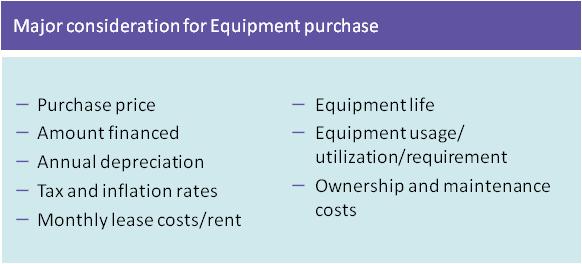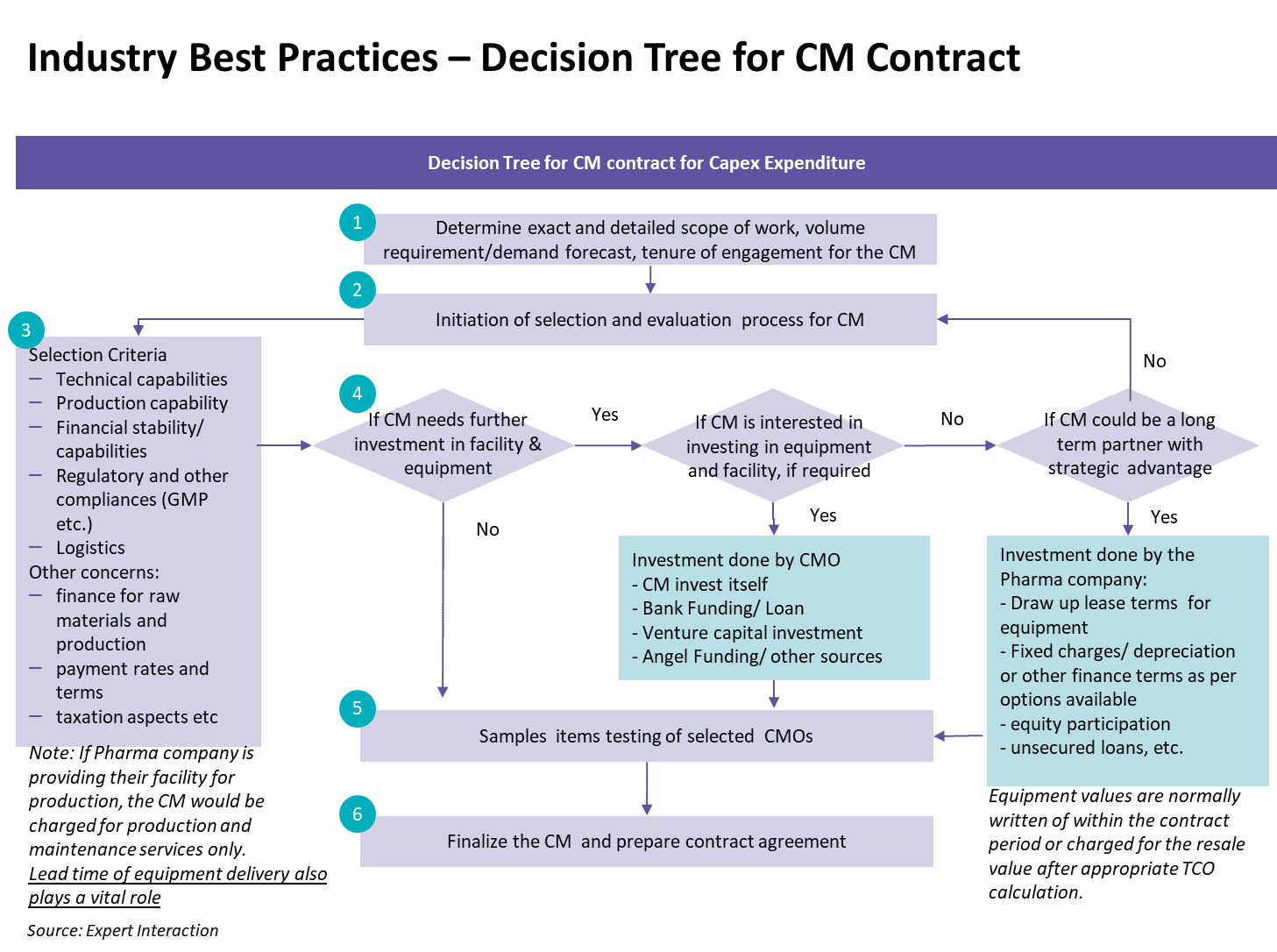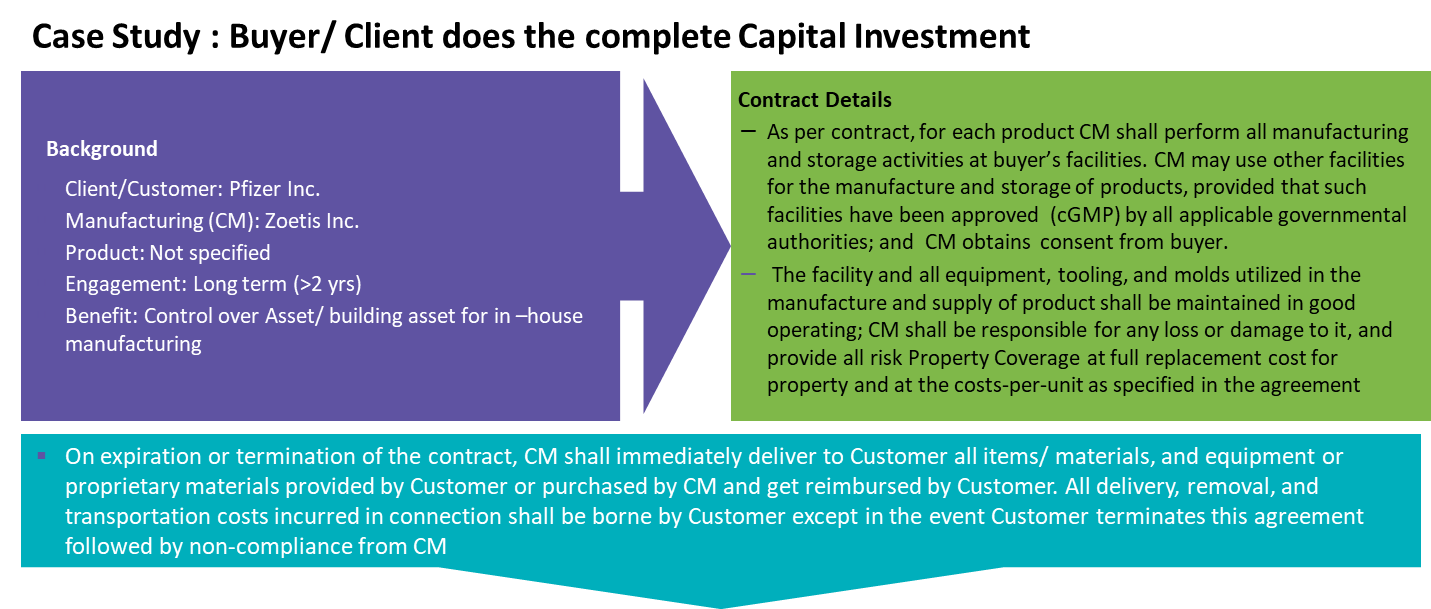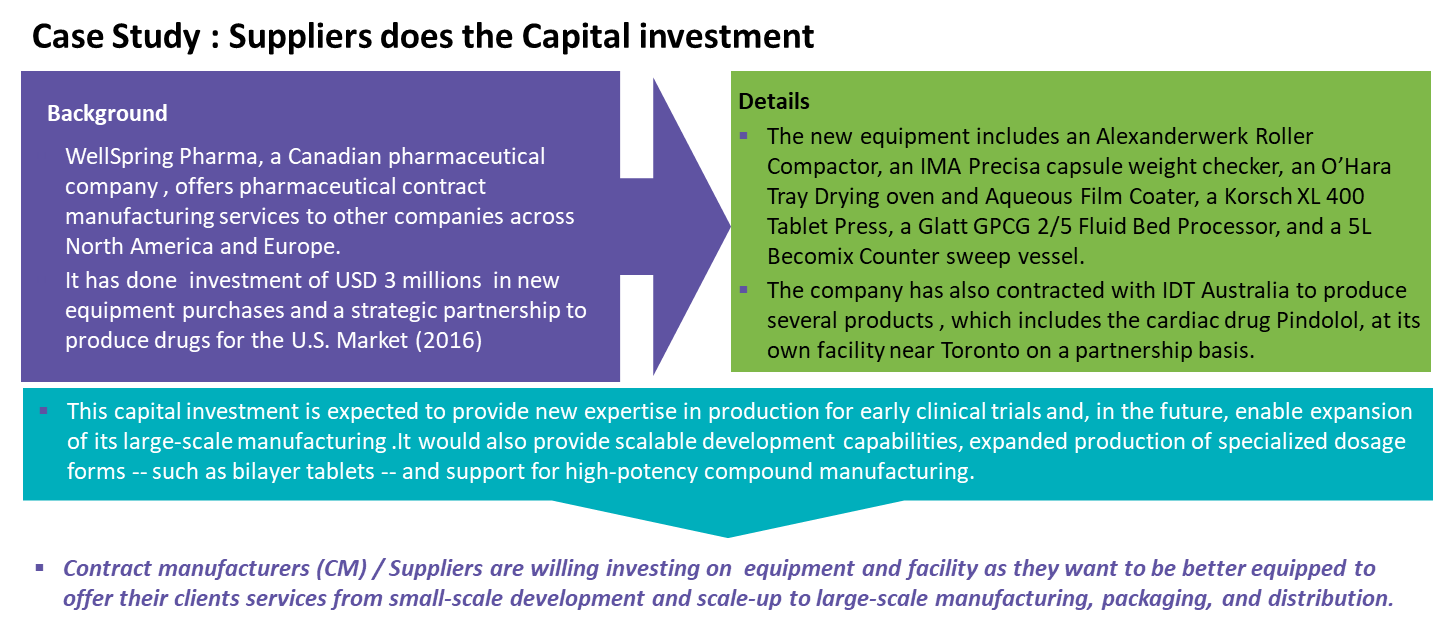
Addressing Capex decisions in Contract Manufacturing


Contract Manufacturing is growing rapidly and has become a necessity for maintaining competitive advantage. Most large CPG and pharmaceutical buyers require a huge number of assets to carry out their production, research, and product development processes. With shorter product life, the technologies of such assets also become obsolete after a certain time period. These companies accumulate a huge amount of capital locked up as inventory in these assets. Many organizations are therefore taking this issue very seriously.
Who should procure the equipment and assets required for production while engaged in a contract manufacturing arrangement, the buyer or the CMO?
A capital investment for plant and equipment is a very important purchase decision for any organization; it requires a substantial amount of spend, both for initial purchase and over the life of the asset. Whatever the source of investment may be, the organization needs to understand the subsequent spend such as interest expense along with payment terms if borrowed, a long-term commitment to manage the asset if leased, or MRO and disposal cost if purchased. Therefore, the equipment acquisition decision should qualify for performance and value addition throughout its expected life and beyond.
Though identifying the need for upgrading, replacing, or adding to existing capital equipment and machinery often begins in a department outside of supply management such as operation, manufacturing, engineering, and so on. The ultimate decision and execution regarding the capital purchase is mostly done by senior management and the procurement team, respectively. The procurement professionals act as enablers and provide input into the decision-making process. They offer senior management valuable information on suggested investment decisions. This information may include the equipment suppliers' financial situations, service levels, reputations, after market follow-up, technologies and technical abilities, various manufacturers' models as well as the pros and cons of purchasing new, purchasing used, or leasing equipment, pricing structures, and so on. In order to develop an accurate matrix for the buying or leasing option, the buyer should analyze and understand all of the cost factors involved in each option.

Source: Beroe Sources
General Practices in Industry:
There is no one solution that fits all models for CMO engagement. CMO provide a variety of services to the buyer companies, starting from the production development phase to the product commercialization phase. The nature CMO contracts in the pharmaceutical industry would highly depend on type of drugs such as small chemical-based small molecule, biologics-based large molecule or patented, generic drugs, and so on, the nature of contracts and level of commitment (in terms of resources and efforts).
As a general practice, most of the time buyers purchase the majority of the equipment needed by CMOs upon the transfer/implementation of the manufacturing of a new drug product at their sites. There are no clear criteria on when/why such investment should be made upfront. Not just on the financial front, but such arrangements also create additional complexity for external management of assets, guarantee, replacement in case of failures, and so on.
Therefore, the decision should be taken on the basis of a detailed lifecycle cost analysis or total cost of ownership analysis for each of the various options available. Lifecycle costing looks at the purchase price or lease commitment, delivery, installation, training, spare parts, maintenance, depreciation, disposal of existing equipment, future disposal of this new equipment or expense of moving to another location, plant layout changes, interest expense as needed, and so on. Though lifecycle analysis is a tiresome process, it has the potential to offer an improved basis for comparing equipment suppliers, equipment models, purchase options, and so on. The following is a simple decision enabler:

Note: If company is providing their facility for production, the CM would be charged for production and maintenance services only. Equipment delivery lead time also plays a vital role. Equipment values are normally written off within the contract period or charged for the resale value after appropriate TCO calculation.
Alternative Scenario Comparison for CapEx Investment
If any client has to invest, it definitely ensures that there is sufficient business to cover the cost of owning the equipment and servicing the capital invested through capital repayment, interest, depreciation and so on. The service contract for Product Development (PDS) CMO services is more collaborative in nature, where clients do share some of their IPs, assets in terms of technology transfer to the partnering CMO. As most of the time requirement/demand during PDS services is small in quantity, CMO therefore do not prefer exclusively capital investment. However, if the same CMO will be used during the commercialization stage, then clients may consider making the required investment. CMO services for the commercialization phase deals with large volumes and are more suited to CMO for co-investment deals or infrastructure sharing models, even asset leasing deals. Many companies such as Sanofi, Merck, and Pfizer have sold some of their sites to their long associated CMOs as part of a contract to reduce their fixed costs associated with managing these facilities. In such cases, the CMOs are generally allowed to share these manufacturing facilities with other clients to achieve economies of scale.
In the following cases the Client makes the capital investment for CM:
- no existing CM's with the required technical qualifications, and/or
- the company wants to continue an existing contract manufacturing arrangement due to any of the following reasons:
- the client or their promoter’s managing team already has a stake in the CM company
- the client has some commitment to the CM to continue an existing contract and does not want a disruption in supplies and quality control, or does not wish to disclose the formulation to a new CM.

This investment can be made in several ways, the following are a few examples:
- Equity participation in the CM company, and hence participation in the overall profits or losses of the CM company.
- Equipment lease, with the option to purchase after a specified period. The monthly lease rent will be offset against the contract manufacturing payments due to the CMO.
- Secured or unsecured loans. For secured loans it may not be possible to mortgage the machinery or equipment, hence some other form of security may be obtained, which is very difficult to secure because only a financial institution or bank may do so in most countries. Private companies are not allowed to secure mortgages from another company.
In all of the above cases, there is an inherent financial risk involved with a possibility to lose part or even the entire fund invested. Following is a case study where the supplier has done the required capital investment;

Emerging Trends in Industry
1. Accessing a 3rd Party Facility for Production:
A new emerging business model presents a different solution that provides ready-to-use and GMP-compliant bio manufacturing facilities with integrated support services. This new concept offers flexibility for GMP bio-manufacturing in a pay-as-you-use model. Such concepts are mostly adopted in clinical or product development with a small quantity requirement.
|
Bio-Manufacturer |
Scenario Assessment |
Benefits /Advantages |
|
|
Small to Mid-size Pharmaceutical Companies |
|
|
|
|
Large Size Pharmaceutical Companies |
|
|
|
|
Contract Manufacturing |
|
|
|
2. Partnerships -Used Equipment Suppliers:
As another trend, companies are looking for a trusted strategic partner who can provide support through the entire selling and buying activity of manufacturing equipment. Major drivers for this strategy are cost pressures for new investment and underutilization of assets; the average asset utilization of any global top 25 pharma company is only around 45%. Hence, companies are looking to eliminate redundancies to enhance efficiency and increase productivity.
Basically, these suppliers offer a complete range of value-added services to both used or redundant asset owners and those looking to purchase them. Such partnering vendors do have an understanding pharmaceutical laboratories, processing, and packaging equipment, have an established network across the industry, are able to provide comprehensive customer support from certified appraisals to strategic management services, and so on. Experienced equipment dealers can also very effectively support the recovery needs of large pharmaceutical companies with multiple sites around the world. In general, used assets/process equipment are often sold at 40-50% (sometimes even <20%), depending on the remaining life of the asset, of the cost of new systems. The sale of used pharmaceutical equipment helps asset owners recover some of the initial investment made in assets that are no longer useful to them. The purchase of used equipment also saves buyers money and provides significantly reduced lead times.
Available Liquidation Options
A huge amount of the client is locked up as plant and equipment. Proper liquidation strategy would help in recovering some value from such assets when compared to scraping/disposing of them. The organization should leverage various liquidation channels and gain as much as possible from the surplus assets.
The decision to liquidate depends on various considerations such as warehousing space requirements for unused equipment, target resale value, closing of accounts, nature of demand for the type of equipment the organization, and so on.
- In house liquidation teams could be one of two types: Asset disposal networks and a dedicated asset management team.
- Asset disposal networks/teams are cross functional and help in the effective assessment of the market value of the equipment so as to optimize losses. TEVA Pharmaceuticals, pharma companies from Germany, and ERCROS, Spain follow this model.
- A dedicated asset management team has centralized control and knowledge of surplus and used equipment within the organization across various production lines and across units that gives them an edge over asset disposal networks, which are formed on an ad hoc basis. For example, BASF Chemicals, Germany and Dow Chemicals, U.S. practice this model.
- External Liquidation Channels are preferred because of their larger buyer reach, knowledge of the markets, and integrated services that tend to reduce transaction costs.
Examples of external liquidation channels include equipment dealers/distributors, classifieds and Ads, E-retail markets, auction houses, private treaty sales, asset management companies, and so on. External channels are mostly preferred because it reduces the huge cost burden of maintaining an internal team. Again, lack of experience and exposure to real value of redundant assets or the market place to redeploy or sell the assets or insufficient knowledge on the world-wide buyer-base makes it less profitable as a venture.
Market based asset valuation is the commonly followed valuation approach in the market. The following can be considered as benchmark for returns at each life cycle stage for used equipment
|
Asset Valuation Approaches |
||
|
Cost Focused |
Market Based |
Income based Approach |
|
The value is derived based on the cost of the substitute with identical utility of the used equipment. |
|
|
|
The valuation method holds good only for new or specialized equipment. |
|
|
|
Depreciation estimate is subjective in this approach. |
|
|
Conclusion
There are no standard agreements to highlight remuneration structures for new equipment purchases while engaging with CMOs. The financial arrangements are prepared on a case-by-case basis depending on various aspects of the contract.
|
Available Options |
Financial Risk |
Ease of implementation |
|
|
Pay-as-used |
Written off the net value of the equipment within the contract period. |
|
|
|
Equipment leasing/renting |
If cost of equipment is very high and expected utilization is lower or required usage time is less than a certain number of years (Ideally less than 3 years). |
|
|
|
Co-investment deals or infrastructure sharing |
Example: Sanofi, Merck, and Pfizer have sold some of their sites to CMOs as part of a contract. |
|
|
|
Modular Manufacturing units |
3rd party who can provide ready-to-use and GMP-compliant bio manufacturing facilities with integrated support services (only for small quantity production). |
|
|
|
Used equipment supplier and service provider |
Provide support through the entire selling and buying experience for both used or redundant assets. |
|
|
Last but not least, the historical relationship between the brand owners/clients and CM companies should be meticulously evaluated. A few basic questions can help in evaluating actual synergy between both parties. Have they stood by each other in times of crisis in the past? Would they also be willing to do so in the future? Should a company engage with the same management teams or would a different management team be better? An informed decision can always minimise the risk in future.
Related Insights:
View All
Get more stories like this
Subscirbe for more news,updates and insights from Beroe
















